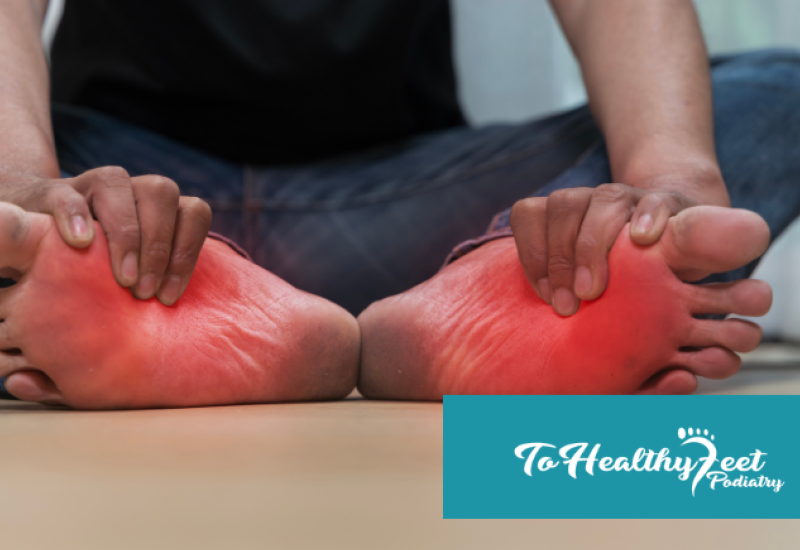What Causes Achilles Tendonitis?
The main cause of Achilles tendonitis is repetitive strain. Because you use your Achilles tendon so frequently to walk, run, and even to stand on your tiptoes, it is easily affected by repeated movement. Some factors that can increase your risk for Achilles tendonitis include:
- Age: Your risk of injuring your Achilles tendon increases with age.
- Gender: Men are more frequently diagnosed with Achilles tendonitis.
- Foot Structure: If you have flat feet you are more susceptible.
- Activity: People who participate in sports have a higher incidence of Achilles tendonitis. Cold weather, uneven terrain, and poor footwear increase your risk.
- Overall Health: Certain medical conditions like psoriasis and high blood pressure and certain medications like antibiotics are linked to higher rates of Achilles tendonitis.
Symptoms Of Achilles Tendonitis
Symptoms of Achilles tendonitis can be more severe after prolonged or intense physical activity and include:
- Pain in the back of the calf, the back of the ankle, and the heel
- Swelling
- Redness
- Stiffness in the calf, ankle, and heel
- Difficulty walking
When Does Achilles Tendonitis Require Surgery?
Achilles tendonitis rarely requires surgery. In most cases it can be treated with advanced non-invasive or minimally invasive options including:
- RICE: Rest, Ice, Compression, Elevation.
- Bracing: This technique will immobilize the foot, limiting movement and encouraging healing.
- Custom Orthotics: This can support and align your foot, correcting foot function and preventing further irritation and injury to the Achilles tendon.
- PRP Therapy: Plasma-rich platelets are obtained from a specimen of your own blood to create a platelet-rich solution that stimulates the production of growth factors to speed healing.
- Tenex: A small instrument with a needle-like point is inserted through the skin into the damaged tendon. Vibrating ultrasonic frequencies break down and remove damaged scar tissue in the Achilles tendon.
If less invasive treatments for Achilles tendonitis are delayed, further damage to the Achilles tendon can occur. In some rare cases, this requires surgical intervention. When surgery is necessary it can often be completed with minimally invasive surgical techniques to minimize risk and shorten recovery.
Surgical And Non-Surgical Achilles Tendonitis Treatment In NYC
The symptoms of Achilles tendonitis can range from mild to severe. The key to avoiding extreme symptoms and the need for surgical intervention is early diagnosis and treatment. Don’t ignore Achilles tendon pain. See your podiatrist for accurate assessment and customized strategies to heal Achilles tendon strain or injury and get back on your feet again.
The team of foot doctors at To Healthy Feet in Manhattan can expertly assess your feet to determine the cause of your Achilles tendon pain, and develop a personalized treatment strategy based on the severity of your symptoms, your lifestyle, and your goals for treatment. We provide accurate diagnosis and comprehensive foot and ankle care and have the tools and technologies necessary to provide a variety of tailored treatment approaches including regenerative medicine, prescription medications, and even minimally invasive surgery (when needed) at each of our Manhattan Podiatry Clinics.
If you are experiencing pain due to Achilles tendon injury
or any other foot or ankle condition, call To Healthy Feet Podiatry at 1-917-398-3668
or fill out the contact form to book your appointment at our
Upper East Side, Times Square, Midtown Grand Central, or Downtown Wall Street locations today.
FAQ
Q: How can I prevent Achilles tendonitis?
A: Warm up before and cool down after your workout routine. Slowly increase the intensity of your exercise over a period of time. If you're using equipment at the gym, make sure you know how to use it safely and also with the form and posture. If unsure, always ask!
Q: What is a quick and easy way to stretch my Achilles tendon?
A: Grab a resistance band (or even a stretchy t-shirt). Place the band or shirt around the ball of your foot. Pull the two ends of the band or shirt towards you until you feel a nice stretch in the back of your leg. Hold this stretch for 30 seconds, and relax for 10 seconds. Repeat this 5-10 times for both legs.
Q: Can I recover from Achilles tendonitis by myself?
A: Yes. There are many Achilles tendonitis treatments that you can try at home. These include resting, keeping the affected foot elevated and compressed, applying ice, and stretching.




